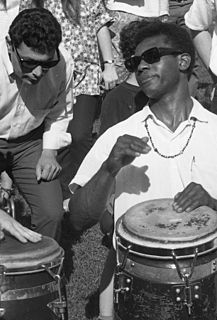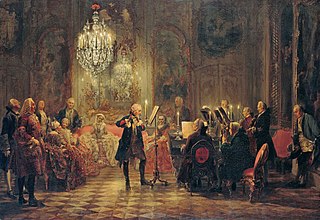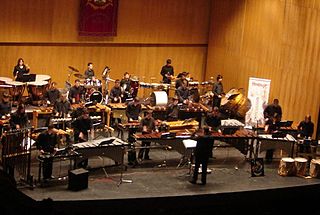
A cymbal is a common percussion instrument. Often used in pairs, cymbals consist of thin, normally round plates of various alloys. The majority of cymbals are of indefinite pitch, although small disc-shaped cymbals based on ancient designs sound a definite note. Cymbals are used in many ensembles ranging from the orchestra, percussion ensembles, jazz bands, heavy metal bands, and marching groups. Drum kits usually incorporate at least a crash, ride, or crash/ride, and a pair of hi-hat cymbals. A player of cymbals is known as a cymbalist.

A percussion instrument is a musical instrument that is sounded by being struck or scraped by a beater ; struck, scraped or rubbed by hand; or struck against another similar instrument. The percussion family is believed to include the oldest musical instruments, following the human voice.

A drummer is a percussionist who creates music using drums.

George Henry Crumb or George Henry Jr. Crumb is an American composer of modern classical and avant-garde music. He is known as an explorer of unusual timbres, alternative forms of notation, and extended instrumental and vocal techniques, which obtained his innovative techniques in the use of vivid sonorities. Examples include seagull effect for the cello, metallic vibrato for the piano, and using a mallet to play the strings of a double bass, among numerous others.

John Luther Adams is an American composer whose music is inspired by nature, especially the landscapes of Alaska, where he lived from 1978 to 2014. His orchestral work Become Ocean was awarded the 2014 Pulitzer Prize for Music.
Third Coast Percussion is a Grammy Award-winning American percussion ensemble, based in Chicago, Illinois, United States.
Living Toys, Op. 9, is a composition for chamber ensemble by the English composer Thomas Adès. It was written in 1993 as a part of his MPhil portfolio in Composition at Cambridge University and premiered at the Barbican Hall in London under Oliver Knussen.
Anaklasis is a musical composition for 42 string instruments and percussion, composed in 1960 by the Polish composer Krzysztof Penderecki. It was first performed at the Donaueschingen Festival in West Germany in 1960. At this first performance, it was well received by the audience who demanded an encore.
Heimdall's Trumpet is a concerto for trumpet and orchestra by the American composer Christopher Rouse. It was commissioned by the Chicago Symphony Orchestra for its principal trumpeter Christopher Martin. The piece was completed January 21, 2012 and premiered December 20, 2012 at Symphony Center in Chicago.
The Clarinet Concerto is a concerto for clarinet and orchestra by the American composer Christopher Rouse. The work was commissioned for the Chicago Symphony Orchestra and its principal clarinetist Larry Combs by the Institute for American Music. It was completed December 11, 2000 and premiered May 17, 2001 at Symphony Center in Chicago with Christoph Eschenbach conducting the Chicago Symphony Orchestra. The piece is dedicated to Rouse's friend and fellow composer Augusta Read Thomas.
Prospero's Rooms is a single-movement orchestral composition by the American composer Christopher Rouse. The work was commissioned by the New York Philharmonic, for which Rouse is composer-in-residence, and was completed in 2011. The title comes from the Edgar Allan Poe short story "The Masque of the Red Death," in which the main character Prince Prospero and his fellow aristocrats try to escape the ravages of a plague known as the "Red Death" by locking themselves away from the outside world during a masquerade ball.
Gregory Spears is an American composer of instrumental and operatic works that blend aspects of romanticism, minimalism, and early music. Among his best known works are the operas Fellow Travelers and Paul's Case, as well as his Requiem.
Astral Canticle is a double concerto for violin, flute, and orchestra by the American composer Augusta Read Thomas. The work was Thomas's sixth and final commission by the Chicago Symphony Orchestra before she concluded her nine-year tenure there as composer-in-residence. It was first performed in Chicago on June 1, 2006, by the flutist Mathieu Dufour, the violinist Robert Chen, and the Chicago Symphony Orchestra under the conductor Daniel Barenboim. The piece is dedicated to Barenboim and the Chicago Symphony Orchestra. The composition was a finalist for the 2007 Pulitzer Prize for Music.
The Cello Concerto No. 3, Legend of the Phoenix, is a composition for cello solo and orchestra by the American composer Augusta Read Thomas. The work was commissioned by the Boston Symphony Orchestra with contributions from Bill and Solange Brown. It was first performed in Boston on March 14, 2013, by the cellist Lynn Harrell and the Boston Symphony Orchestra under the conductor Christoph Eschenbach. Thomas subsequently adapted the piece into a viola concerto in 2013.
The Wind in High Places is a composition for string quartet by the American composer John Luther Adams.
Kraft is a composition for solo ensemble, electronics, and orchestra by the Finnish composer Magnus Lindberg. The work was commissioned by the Helsinki Festival and was first performed on September 4, 1985 by the Toimii ensemble and the Finnish Radio Symphony Orchestra under the direction of Esa-Pekka Salonen. The piece was awarded the International Rostrum of Composers in 1986 and won the Nordic Council Music Prize in 1988.
Quintet for Clarinet and Strings is a chamber work in four movements, for B♭ clarinet and string quartet, by American composer Geoffrey Gordon (1968).
Geoffrey Gordon is an American composer of classical music.
All These Lighted Things is an orchestral composition by the American composer Elizabeth Ogonek. The work was commissioned by the Chicago Symphony Orchestra, for which Ogonek co-serves as Mead composer-in-residence with the composer Samuel Adams. The piece was given its world premiere by the Chicago Symphony Orchestra under the direction of Riccardo Muti on September 28, 2017.








